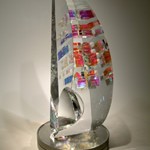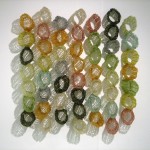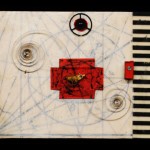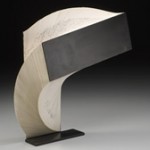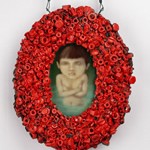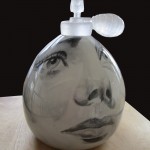Marta Hewett Gallery: “This is contemporary art.”
By Karen Chambers
Even though the computer ate gallery owner Marta Hewett’s “What Is Contemporary Art?” essay for aeqai, it set her to thinking about the question. (For how other citizens of the art world answered that question, see the September issue.)
Once on this path, Hewett came up with the most expansive response possible: contemporary art is art that is being made today by living artists. “All that contemporary means is current,” Hewett explains. “It doesn’t describe a style.” (See Jason Frantz’s “What Is Contemporary Art” in the September aeqai for a similar take.)
Hewett’s nonverbal answer to the question is an exhibition declaring, “This is contemporary art.” It features multiple works by 20 artists — some from her own stable, some local artists she had never shown, and at least one she found on the website beautifuldecay.com, a “Daily Blog for Art and Design.”
In organizing the exhibition, Hewett wanted to show a range of styles from representational to abstract and a variety of mediums, including glass that is blown, kiln-formed (chunks of glass fused together in a mold), or cut-and-polished; acrylic paint on canvas, wood, steel, and plexiglass; thrown and hand-built ceramics; fiber including silk and twill; fiberglass; bronze; paper; encaustic; graphite; digital photomontage; and assemblage and collage. Yet she has not included what many consider to be the art forms of the times, namely installation, performance, video, computer-generated or web-based work.
I see two possible reasons. One is that it isn’t very interesting to her (me either). The second is that as a gallerist, she needs objects to sell. I certainly don’t begrudge her that since sales benefit the artist and, hopefully, enrich the collector.
But let me talk about what Hewett did include. When I walked into her space at the Pendleton Art Center, I was literally dazzled by Toland Sand’s two sculptures of cut-and-polished crystal with dichroic glass. (Coming from the Greek and meaning many-colored, dichroic glass is a thin piece of plate glass with a molecular coating, which causes the color to change according to whether light is transmitted or reflected.)
Sand aimed to create “a field wherein light and images can dance around as one moves around the piece,” something that he has certainly achieved in Architectonic. A thick semi-circular block of 32%-lead-crystal-and-borosilicate-optical glass, which is virtually colorless, sits on a turntable. Viewers are encouraged to spin it to see the effects of the dichroic glass and how the interior walls act as mirrors, the ephemeral image doubling and re-doubly infinitely, like Robert Morris’s mirrored works or Yayoi Kusama’s Infinity Mirror Room.
Sand’s composition of dichroic glass looks magically embedded in the center of the crystal block, but it’s not done by magic. Instead it’s the result of an incredibly labor-intensive process; each Sand piece takes between six and eight weeks to complete.
Sand reveals, “Large blocks of glass are cut up with a diamond-tipped saw to the appropriate size and then ground and polished. Dichroic-coated glass is sandwiched between the layers as it is glued, with a different color used each time, interspersed between leaded and non-leaded glasses.”
What results, if not magical, is beautiful, which has won him collector approval and sales. I say more power to him, but as someone who has written extensively about glass, I always find such work too beautiful.
On a nearly five-hour road trip from the Corning Museum of Glass to Manhattan in a car filled with glass artists, one asked me what I thought of his work. My answer was an admittedly mealy-mouthed “interesting.” And his? “You mean too beautiful.” Guilty. I don’t advocate ugly, but I prefer work that is more than eye candy.
But I have a bigger problem with Sand’s work. It’s a dead-ringer for that of a much better-known glass artist: Christopher Ries, right down to the lazy Susan presentation. Looking derivative is an unforgivable sin in my book.
Once I got past the Sands, I was drawn to four of Melissa Parrott Quimby’s slender vessels built up of Band-Aid-like strips of clay. She’s titled them flatfootedly: Orange Linear Vessel I and II and Blue Linear Vessel I and II. On the surface, she has “scribbled” in apricot over écru, and blue over a lighter blue.
Quimby explains, “Through an instinctual impulse of combining line and color, I create my own interpretation of three-dimensional drawings. The microscopic detail lures the viewer into the sculptures for a closer look and deeper enjoyment.”
But the marks are so subtle that you simply can’t see them from a distance and so can’t entice you to come closer. It’s the forms that bring you in. They are reminiscent of Giorgio Morandi but also the ceramic artist Jim Makin’s vessels that are hand-thrown with obvious finger marks, which correspond to Quimby’s strips.
Hewett sought to spark conversations between pieces in her installation. Nowhere is that clearer than with Tim Harding’s Geranium Spiral and Orange & Pink Spiral. He’s sewn together raw-edged strips of dyed-silk to construct spiraling patterns, which I saw as full-blown roses.
The movement Harding has created takes up a dialogue with Frank Herrmann’s Asmat Cloud I with its blue worm-like or fat comma forms crawling over an earthy brown-gold ground. Covering about three-fifths of the canvas, he’s added roiling blue shapes above them in thick acrylic paint impressed with what looks like a bubble wrap.
A Stone Age society, the Asmats are an ethnic group from New Guinea living in the Papua province of Indonesia. Herrmann’s interest in their art was sparked in 2000 when his son gave him a book on it. But as Ruth K. Meyer writes in her essay, “Frank Herrmann: Modernist and Primitivist” in Frank Herrmann: Paintings 1999-2009, “He suddenly recognized that he had been doodling and sketching Oceanic motifs for quite some time.”
After recognizing this affinity, Herrmann began to study and collect Asmat art, and consciously incorporating “the culture’s myths, symbolism, and striking motifs” into his painting.
The Asmat are known for their woodcarvings, which are used as vestments, utensils, and emblems of rituals in their religious and spiritual traditions. Their tribal practices are linked to their creation myths and honoring their ancestors. The work “is invested with spirituality and respect, with references to the natural and supernatural world,” according to Herrmann in his essay “About the Paintings” in the monograph cited above.
“This culture’s art offers me the ability to take on a new artistic language, which is honest, without pretension, and imbues reverence and spirituality into inanimate objects,” he shares
The inspiration Herrmann derives from his study of the Asmat culture could only be known by a student of it, but that does not lessen the aesthetic experience. It’s not dissimilar to Yvette Kaiser Smith’s dependence on math.
In Smith’s artist statement, she writes:
In terms of identity, math is the underlying principle in all of life and, as the search for numbers went on for thousands of years, numbers represent the human search for knowledge.
She bases her work on two mathematical concepts: pi and Pascal’s Triangle. A math illiterate, I turned to Wikipedia:
The number π is a mathematical constant that is the ratio of a circle’s circumference to its diameter, and is approximately equal to 3.14159. . .
Being an irrational number, π cannot be expressed exactly as a ratio of any two integers.
And Wikipedia defines Pascal’s Triangle as “a triangular array of the binominal coefficients.”
Using these parameters, rather like Sol LeWitt’s drawings based on simple instructions, such as in Wall Drawing #122 — “all combinations of two lines crossing, placed at random, using arcs from corners and sides, straight, not straight and broken lines” or John Cage’s use of the I Ching in his musical and visual compositions, Smith assigns colors and a sequencing pattern to create her crocheted fiberglass sculptures.
Installed on the wall, Pi Stands is an irregular grid of crocheted “cuffs.” (They bring back a childhood memory of the knitted sleeves used to absorb condensation on anodized aluminum tumblers.) There are seven vertical lines composed of seven or eight cuffs, in no discernable (to me) order.
The translucency of her material and attractive palette from grub (sorry for the unpleasant association) to celery to seaweed to evergreen; lemon to amber; blues from sunny to stormy skies; and a pink with a tiny bit of yellow, neither peach nor salmon, makes for a formally satisfying visual experience.
Raymond Papka’s encaustic-and-assemblage-on-wood-panel artworks are also science-related. He studied zoology and chemistry as an undergraduate, and holds a Ph. D. in anatomy and neuroscience. Although not formally trained as an artist, Papka sees that his “training as a research scientist further utilized and expanded my knowledge of photography, layout, technical skills, and sense of creativity, design, structure, imagination, and interpretation.”
Papka’s works are an engaging and romantic mix of scientific-looking images, purely abstract areas, and all manner of found objects that come from his collections.
In his artist statement, he writes:
I am attracted to found objects that look as though they have once come from something interesting, belonged to a mysterious family, or that look valuable, but may have had little or no importance to others such as old forks, buttons, old letters, and metal remnants. I always have had collections of small objects, coins, arrowheads, old rusty items, and fascinating ‘things’ in little boxes and cloth bags (my favorite was the old Bull Durham tobacco bags and cigar boxes that I got from the smoke store in my hometown of Thermopolis, Wyoming).
Those items find their way into his delightful puzzles that he challenges the viewer to decipher. Again, he writes:
I like to generate layers of information in my artwork, but keep it mysterious . . . almost dreamy. . . I feel that it is not necessary to have people completely understand my art, merely question what is occurring and be able to grasp a feeling that each piece generates.
In Continuum II, a tightly wound metal ribbon uncurls, leading the eye through the composition, over straight lines that cross and intersect with a circle drawn in the encaustic (beeswax melted with Asian fir resin) ground. Along the right side is a band of alternating black and white bars, rather like a comb with widely spaced teeth. A red cross is in the center, its horizontal crossbar slightly smaller than its vertical. In the cross’s center is a yellow bird, a songbird perhaps. There are also tools or instruments whose purpose I can’t identify.
The result is an engaging artwork whose meaning stays maddeningly beyond full comprehension.
Although Papka did not exhibit any of his “altered books,” he loves old volumes, which he has recycled as he “continually utilize(s) themes involving text.”
Andrew Hayes also loves books, but for him a “book is a seductive object to hold and smell and run your fingers through. I am drawn to books for many reasons; however, the content of the book does not enter my work,” he notes. “The pages allow me to achieve a form, surface, and texture that are appealing to me.”
In Swarm, a block of pages fans out, swooping upwards like a helix. The progress is stopped mid-air by a thin steel rectangle that functions like a book cover.
As I already said, Hewett was very conscious of the placement of works so as you enter the second gallery, you see the back of Lyndsey Fryman’s ceramic Unanswered Questions, or more correctly a three-quarters-turned back of the figure positioned to look at Flex Box by Smith, which is mounted on the wall.
Circling around, you see the 42”-tall figure is a young nude girl. I say “girl” since the sex is hidden by a continuous loop of scarf made up of bits of clay pressed together. It covers her shoulders, drapes over nonexistent arms, and sags in such a way as to suggest intertwined fingers.
Wearing feathers in her hair, her full mouth is turned down. A band of white, like a blindfold, covers the top half of her face. She gazes upward with sad-looking dark and shiny glazed eyes.
Fry’s inspired by her experience as the mother of an autistic child.
. . . (T)he imagery in my work is inspired by how we communicate our physical needs and psychological states. . . These figures represent a being that has experienced a mature range of emotions, within a young child’s form. My hope is that my pieces engage the viewer in an unspoken dialogue that spurs a curiosity, awareness, and concern for others.
Steven Ramsey’s (see the November 2011 issue of aeqai for my review of his exhibition at Marta Hewett) strange figures actually trump Fryman’s preternaturally wise child. In Shiver, he has painted in enamel on a glass panel another nude child of unidentified gender, although I’ll again designate one: male. With an outsized head, he wraps his arms around his bare chest and stares out without expression. Disturbing doesn’t begin to describe the scene. Shivering because of the cold or because of some malevolent force? Ramsey hints of a tale but leaves it up to the viewer to tell it.
The painted panel is surrounded by a waxy-red kiln-formed glass frame. From a distance, it appears to be a conventional if elaborately wrought frame, but up close you that it has been cast from unexpected objects such as nuts, bolts, and washers so you’re whipsawed from something verging on unnatural to the absolutely mundane. (The relationship of frame and the framed also intrigued Celene Hawkins’ in “Landscape: Re-Framed” at the Taft Museum of Art, August 2-October 20, 2013. See my review in the August 18, 2013, edition of the Cincinnati Enquirer, “Her nature: re-framed.”)
There’s also ambivalence in Joanna Manousis’s two oversized blown-glass perfume bottles with grisaille female heads trapped inside. With spiky, heavily mascaraed eyelashes and bee-stung lips, they appear to be the same woman. She looks like a conventional beauty although her features are slightly distorted by the shapes of the bottles. Self-contained Spray is shaped like an Erlenmeyer flask, a cone-shaped container with a neck, and Self-contained Perfume is a bottom-heavy orb.
Since glass techniques do confound those unfamiliar with them, let me get her technique out of the way. A glass bubble is blown and after being allowed to cool, the artist paints on it with enamels, which will be fired on. Thus decorated, it can be reheated and another layer or gather of glass added, encasing the painting before the bubble is shaped into its final form.
Manousis uses the technically demanding process “to induce reflection, both physically and metaphorically, in the viewer. It is the transparency of glass, a solid state of atmosphere that simultaneously reveals yet barricades that I find most compelling.”
Manousis’s ladies are unlikely to have been the virgins that the protagonist in Patrick Suskind’s 2001 novel Perfume: The Story of a Murderer stalked and killed. Set in 18th century France, a perfumer’s apprentice becomes obsessed with creating the ultimate perfume and murders innocents to capture their scent, their essence.
In thinking about what contemporary art is, Hewett discounted what many people outside the art-world bubble believe about it, that it is difficult or esoteric. There is lots of very accessible art in her visual manifesto, but it seems to me that the title of this exhibition should have been “This Is Contemporary Art I Like. And I Hope You Do Too.”
“This is contemporary art: Selected works by regional and national artists,” Marta Hewett Gallery, 1310 Pendleton St., Cincinnati 45202, 10 a. m.-5 p. m. Tuesday-Friday, 11 a. m.-3 p. m. Saturday. Closes October 26. 513-281-2780, www.martahewett.com.
- Manousis – self contained fragrance
PHOTOS:
- Toland Sand, Architectonica, cut and polished lead crystal and dichroic glass, 16.5” x 10” x 5”
- Melissa Parrott Quimby, Orange Linear Vessel, ceramic, 14” x 8” x 3.5”
- Tim Harding, Geranium Spiral, hand-cut silk, 32” x 32”
- Frank Herrmann, Asmat Clouds I, acrylic on canvas, 56” x 48”
- Yvette Kaiser Smith, Pi Strands, crocheted fiberglass and polyester resin, 40” x 40” x 6”
- Raymond Papka, Continuum II, encaustic and assemblage on wood panel, 8.5” x 11.5” x 2”
- Andrew Hayes, Swarm, paper and steel, 13″ x 14″ x 2″
- Lyndsey Fryman, Questions Unanswered, 42” x 15”, ceramic
- Steven Ramsey, Shiver, glass, 10” x 8.5” x 2.25”
- Joanna Manousis, Self-contained Perfume, blown and enameled glass


